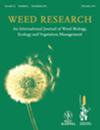CO2浓度升高可促进水稻种子碎裂,影响碎裂基因的表达
IF 2.2
3区 农林科学
Q2 AGRONOMY
引用次数: 0
摘要
杂草水稻(Oryza sativa L.)被广泛认为是全球栽培水稻系统的主要制约因素。落粒与田间杂草生态型的侵入性和持久性有关,并加剧了其在栽培水稻系统中的控制。碎裂性状受遗传和不同环境条件的控制。目前,快速变化的环境,包括不断上升的二氧化碳水平,可能会改变粉碎的频率,从而对杂草种子的投入和竞争产生后续影响。本研究的目的是评估受杂草水稻基因型和大气CO2浓度影响的种子破碎与种子破碎转录调控基因之间的相互作用。我们检测了7种生物型和两种大气CO2浓度:环境{a[CO2]}和增强{e[CO2]}浓度,分别为400和700µmol mol-1。我们的研究结果表明,e[CO2]增加了杂草水稻种子的破碎。基因表达分析表明,[CO2]对所有基因破碎相关基因(OsCPL1、qSH1、Sh4、SHAT1、OsXTH8、OSH15和SH5)的表达均有影响,且基因型之间存在很大差异。结果表明,CO2浓度的升高对杂草稻籽粒破碎的影响较大,对栽培稻籽粒破碎相关基因的影响较小,其中杂草稻籽粒破碎相关基因的上调幅度最大。因此,CO2浓度增加对水稻穗数和籽粒产量的影响主要表现在栽培水稻上。本文章由计算机程序翻译,如有差异,请以英文原文为准。
Elevated CO2 concentration enhance Oryza sativa seed shattering and affects seed-shattering gene expression
Weedy rice (Oryza sativa L.) is widely recognized as a major constraint in cultivated rice systems globally. Seed shattering is related to the invasiveness and persistence of weedy ecotypes in field and exacerbates its control in cultivated rice systems. Shattering traits are controlled genetically and by different environmental conditions. At present, a rapidly changing environment, including rising levels of carbon dioxide [CO2], could alter shattering frequency, with subsequent effects on weed seed input and competition. The objective of the current study was to evaluate the interaction between weedy rice seed shattering and the transcriptional seed shattering-regulation genes as affected by weedy rice genotypes and atmospheric CO2 concentrations. We examined seven biotypes and two atmospheric CO2 concentrations: ambient {a[CO2]} and enhanced {e[CO2]} concentration, 400 and 700 µmol mol-1 respectively. Our results indicate that e[CO2] increases weedy rice seed shattering. The gene expression analysis demonstrates an effect of [CO2] in the expression of all gene shattering-related genes (OsCPL1, qSH1, Sh4, SHAT1, OsXTH8, OSH15, and SH5), with high variability observed between genotypes. Here we showed that increased CO2 concentration affects greatly seed shattering in weedy rice and in minor effect cultivated rice, by modulation of seed shattering-related genes and weedy genotypes showed the highest upregulation level of this genes. Thus, increased CO2 concentration positively affect panicle number and grain yield mainly in cultivated rice.
求助全文
通过发布文献求助,成功后即可免费获取论文全文。
去求助
来源期刊

Weed Research
农林科学-农艺学
CiteScore
4.30
自引率
0.00%
发文量
41
审稿时长
12-24 weeks
期刊介绍:
Weed Research is an international peer-reviewed journal that publishes topical and innovative papers on weed science, in the English language. Its aim is to publish the best weed science from around the globe and to be the journal of choice for weed science researchers. It is the official journal of the European Weed Research Society. Papers are taken on all aspects of weeds, defined as plants that impact adversely on economic, aesthetic or environmental aspects of any system. Topics include, amongst others, weed biology and control, herbicides, invasive plant species in all environments, population and spatial biology, modelling, genetics, biodiversity and parasitic plants. The journal welcomes submissions on work carried out in any part of the world.
 求助内容:
求助内容: 应助结果提醒方式:
应助结果提醒方式:


